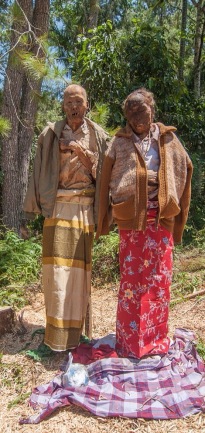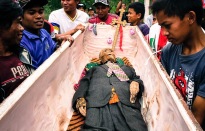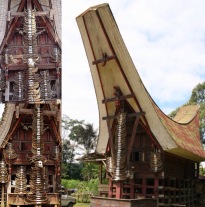 In villages occupied by the Toraja people located in the mountains of South Sulawesi, Indonesia, Shamans have been raising the dead for centuries. While we might refer to the Indonesian walking dead as “zombies”, they are known by the Toraja people as “Rolang”, or “the corpse who stands up”. The only major difference between the Western world’s idea of a traditional zombie and the Indonesian version is that many people have witnessed the Rolang and luckily, they do not crave human flesh. According to the religious beliefs of the Toraja people, in order
In villages occupied by the Toraja people located in the mountains of South Sulawesi, Indonesia, Shamans have been raising the dead for centuries. While we might refer to the Indonesian walking dead as “zombies”, they are known by the Toraja people as “Rolang”, or “the corpse who stands up”. The only major difference between the Western world’s idea of a traditional zombie and the Indonesian version is that many people have witnessed the Rolang and luckily, they do not crave human flesh. According to the religious beliefs of the Toraja people, in order for a deceased person to reach the afterlife known as “Puya” or “The Land of Souls”, their corpse must be returned to the place of their birth for burial.
for a deceased person to reach the afterlife known as “Puya” or “The Land of Souls”, their corpse must be returned to the place of their birth for burial.
 Prior to the Dutch colonization of this area in the 20th century, the Toraja people lived in remote villages without roads connecting
Prior to the Dutch colonization of this area in the 20th century, the Toraja people lived in remote villages without roads connecting one to the other. Due to the difficulty of treading terrain in this mountainous region, people were terrified to journey too far in fears that their body could not be returned to their birthplace in the event of their demise. The Toraja’s beliefs state that if the body is not returned to the corpse’s village of birth, the soul will never reach Puya and will forever wander around in limbo, confused by their unfamiliar surroundings. In order to aid in transporting corpses, Shamans would be called upon to temporarily raise the dead so that they could walk back to their birthplace on their own in order to attend their funeral and begin
one to the other. Due to the difficulty of treading terrain in this mountainous region, people were terrified to journey too far in fears that their body could not be returned to their birthplace in the event of their demise. The Toraja’s beliefs state that if the body is not returned to the corpse’s village of birth, the soul will never reach Puya and will forever wander around in limbo, confused by their unfamiliar surroundings. In order to aid in transporting corpses, Shamans would be called upon to temporarily raise the dead so that they could walk back to their birthplace on their own in order to attend their funeral and begin their journey to Puya. Every August, a ritual known as Ma’nene or “The Ceremony of Cleaning Corpses” takes place.
their journey to Puya. Every August, a ritual known as Ma’nene or “The Ceremony of Cleaning Corpses” takes place.

Corpse cleaning, grooming and redressing during Ma’nene
During this time, families exhume the bodies of deceased relatives in order to wash them, groom them, change their clothes and repair their coffins. The bodies are taken to the place of their death, then back to their grave in the village of origin. Often the deceased are paraded around the village in straight lines
their coffins. The bodies are taken to the place of their death, then back to their grave in the village of origin. Often the deceased are paraded around the village in straight lines during the journey in order to observe the living;
during the journey in order to observe the living;
 This is done out of respect to the ‘Hyang’, unseen spiritual entities with supernatural powers who reside in mountains, hills and volcanoes and may only move in straight lines.
This is done out of respect to the ‘Hyang’, unseen spiritual entities with supernatural powers who reside in mountains, hills and volcanoes and may only move in straight lines.
 Simple wooden caskets
Simple wooden caskets are placed into limestone cliffs in order to make it easier for the bodies to be retrieved for Ma’nene. Some of these limestone burial caves are so old that many coffins have rotted away leaving nothing but skeleton; Some belonging to people who died 1,000 years ago.
are placed into limestone cliffs in order to make it easier for the bodies to be retrieved for Ma’nene. Some of these limestone burial caves are so old that many coffins have rotted away leaving nothing but skeleton; Some belonging to people who died 1,000 years ago.
 Generally coffins belonging to children and infants are suspended from the sides of these limestone cliffs with rope. Once the rope rots and the coffin falls, new ropes are simply reattached and the coffin is hung once more. Infants who die before beginning teething are buried in Baby Grave Trees. [Read all about The Baby Grave Tree here]
Generally coffins belonging to children and infants are suspended from the sides of these limestone cliffs with rope. Once the rope rots and the coffin falls, new ropes are simply reattached and the coffin is hung once more. Infants who die before beginning teething are buried in Baby Grave Trees. [Read all about The Baby Grave Tree here]
 The Toraja, who are known as skilled woodworkers
The Toraja, who are known as skilled woodworkers carve life-sized wooden effigies for high-status villagers which are called “Tau-Tau” and are also displayed on these limestone burial cliffs. Often, the Tau-Tau are dressed with the deceased’s favorite piece of jewelry or clothing. In the Toraja culture, more importance is placed on funerals and The Ceremony of Cleaning Corpses than births and marriages.
carve life-sized wooden effigies for high-status villagers which are called “Tau-Tau” and are also displayed on these limestone burial cliffs. Often, the Tau-Tau are dressed with the deceased’s favorite piece of jewelry or clothing. In the Toraja culture, more importance is placed on funerals and The Ceremony of Cleaning Corpses than births and marriages.
 In addition to returning to their place of birth, Toraja people believe that for a soul to reach Puya, all relatives of the family, no matter how far away, must attend the deceased’s funeral. Due to this stipulation, it can take several weeks, even several months, for the funeral to take place. While awaiting burial, the corpse is taken to a traditional ‘Tongkonan’ house. These houses are used almost exclusively as a place to keep the deceased before burial, similar to a funeral home. Tongkonan houses pass down from generation to generation and cannot be bought or sold according to the Toraja culture.
In addition to returning to their place of birth, Toraja people believe that for a soul to reach Puya, all relatives of the family, no matter how far away, must attend the deceased’s funeral. Due to this stipulation, it can take several weeks, even several months, for the funeral to take place. While awaiting burial, the corpse is taken to a traditional ‘Tongkonan’ house. These houses are used almost exclusively as a place to keep the deceased before burial, similar to a funeral home. Tongkonan houses pass down from generation to generation and cannot be bought or sold according to the Toraja culture.

These elaborate houses are adorned with buffalo horns which are considered to be a symbol of wealth. The roofs’ shape symbolizes prows of the ships which carried the ancient Toraja people to the land they inhabit today. Less wealthy families may instead keep their loved one inside a room of their own home. Prior to burial the corpse is treated somewhat like an actual living person; The body will be washed, groomed, have changes of clothing and will even be offered daily meals.
 It is not uncommon for a visitor to thank the corpse for being a good host. The main reason the deceased are treated so much like the living is because the Toraja people believe it takes many, many years to reach Puya and that in some sense, the deceased remain with their bodies until they complete the voyage. Once all relatives (and the corpse) have arrived in the deceased’s village of birth, the funeral festivities may begin. those attending the funeral will gather in ceremonial sites called “Rante”. Usually, hundreds of people are in attendance at Toraja funerals and for the wealthy, a massive feast is held which may last for several days. It is believed that for the soul to reach Puya more quickly, it is nessesary that blood is spilled at the funeral; The more blood spilled, the faster the journey into the afterlife will be. For this reason, buffalo and pigs are sacrificed at the ceremony. The installment of a new Tau-Tau requires the sacrifice of no less than 29 buffaloes and 59 pigs. For an exceptionally wealthy citizen, dozens of buffalo and hundreds of pigs will be slaughtered while those in attendance sing, dance and try to catch the animals’ blood with bamboo straws. Sometimes cockfights called “bulangan londong” are also held.
It is not uncommon for a visitor to thank the corpse for being a good host. The main reason the deceased are treated so much like the living is because the Toraja people believe it takes many, many years to reach Puya and that in some sense, the deceased remain with their bodies until they complete the voyage. Once all relatives (and the corpse) have arrived in the deceased’s village of birth, the funeral festivities may begin. those attending the funeral will gather in ceremonial sites called “Rante”. Usually, hundreds of people are in attendance at Toraja funerals and for the wealthy, a massive feast is held which may last for several days. It is believed that for the soul to reach Puya more quickly, it is nessesary that blood is spilled at the funeral; The more blood spilled, the faster the journey into the afterlife will be. For this reason, buffalo and pigs are sacrificed at the ceremony. The installment of a new Tau-Tau requires the sacrifice of no less than 29 buffaloes and 59 pigs. For an exceptionally wealthy citizen, dozens of buffalo and hundreds of pigs will be slaughtered while those in attendance sing, dance and try to catch the animals’ blood with bamboo straws. Sometimes cockfights called “bulangan londong” are also held.
 Family will offer the corpse items they feel will be needed for the journey into the afterlife (commonly money and cigarettes). In modern times, bodies are usually transported in cars which means there is not much need for the walking dead; However, it is claimed that Shamans often attend funeral celebrations and can use the same magic to cause a slaughtered buffalo to get up and walk after it has been beheaded. This is to prove the same magic used to create Rolang is still practiced by the Toraja Shamans today. When Rolang was a popular method of transporting corpses to their burial site, special runners would go ahead of these walking dead (who were usually accompanied by a Shaman and family members) to warn people on the path and in villages that a corpse would be shambling through shortly.
Family will offer the corpse items they feel will be needed for the journey into the afterlife (commonly money and cigarettes). In modern times, bodies are usually transported in cars which means there is not much need for the walking dead; However, it is claimed that Shamans often attend funeral celebrations and can use the same magic to cause a slaughtered buffalo to get up and walk after it has been beheaded. This is to prove the same magic used to create Rolang is still practiced by the Toraja Shamans today. When Rolang was a popular method of transporting corpses to their burial site, special runners would go ahead of these walking dead (who were usually accompanied by a Shaman and family members) to warn people on the path and in villages that a corpse would be shambling through shortly.
 Once temporarily reanimated, the corpse would be expressionless, unresponsive, and only able to perform the most basic of functions such as walking. If anyone were to address the corpse by name or unnecessarily touch the body (in a hug, for instance) the corpse would immediately collapse and sometimes, disappear. These migrations to the corpse’s birthplace were also conducted in straight lines and were silent, somber affairs which could take many days, weeks or even months if the person had journeyed too far from home before their demise.
Once temporarily reanimated, the corpse would be expressionless, unresponsive, and only able to perform the most basic of functions such as walking. If anyone were to address the corpse by name or unnecessarily touch the body (in a hug, for instance) the corpse would immediately collapse and sometimes, disappear. These migrations to the corpse’s birthplace were also conducted in straight lines and were silent, somber affairs which could take many days, weeks or even months if the person had journeyed too far from home before their demise.
 The practice remains a complete mystery and although most young people of the Toraja culture do not believe in this ancient practice, the older Toraja population swear it to be real saying it is now only practiced in some areas where it is necessary such as the remote village of Mamases. The practice of regularly exhuming and cleaning corpses can be found in a few other parts of the world such as Madagascar. Unfortunately, it is believed to be a large part of why the bubonic plague, also known as the Black Death is still prevalent in that area. During the 14th century, the Black Death killed an approximate 200 million people. The disease can last in an infected corpse for several years, putting those who exhume and handle deceased infected bodies at risk of contracting the notoriously deadly disease.
The practice remains a complete mystery and although most young people of the Toraja culture do not believe in this ancient practice, the older Toraja population swear it to be real saying it is now only practiced in some areas where it is necessary such as the remote village of Mamases. The practice of regularly exhuming and cleaning corpses can be found in a few other parts of the world such as Madagascar. Unfortunately, it is believed to be a large part of why the bubonic plague, also known as the Black Death is still prevalent in that area. During the 14th century, the Black Death killed an approximate 200 million people. The disease can last in an infected corpse for several years, putting those who exhume and handle deceased infected bodies at risk of contracting the notoriously deadly disease.
Check out the NEW BOOK by The Post-Mortem Post’s Head Writer ‘Horrible History: Mass Suicides’ AVAILABLE NOW on Amazon Kindle!
Photos courtesy Reuters, The Associated Press, Sijori Images and Mongabay.com
Follow us on Twitter @PostMortem_post and Like The Post-Mortem Post on Facebook
Be sure to read about another bizarre funeral rite of the Toraja, The Baby Grave Tree
If you enjoyed this article, you might also like The Zombie Cat Parasite, Pray the Decay Away: Incorruptible Corpses and Other Forms of Postmortem Preservation, The Seven Stages of Decomposition, Everybody Poops: The Postmortem Edition, Mount Everest’s Death Zone, Pascualita: How Much is that Corpse Bride in the Window, How to Drive a Corpse Cross-Country and Rasputin’s Pickled Penis on Public Display

















